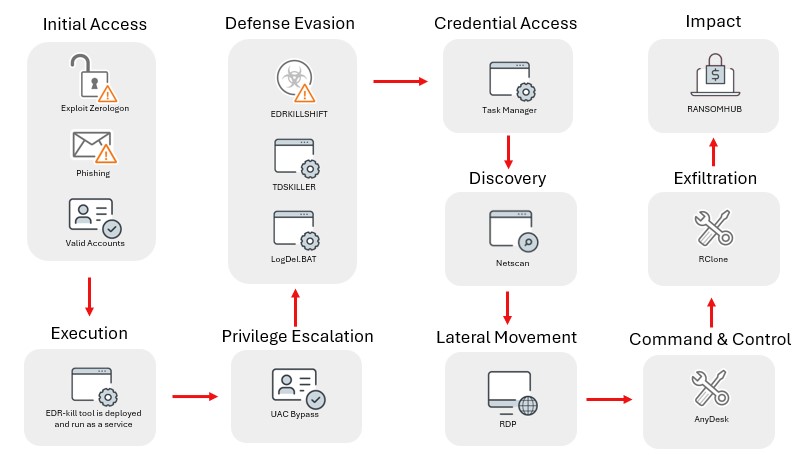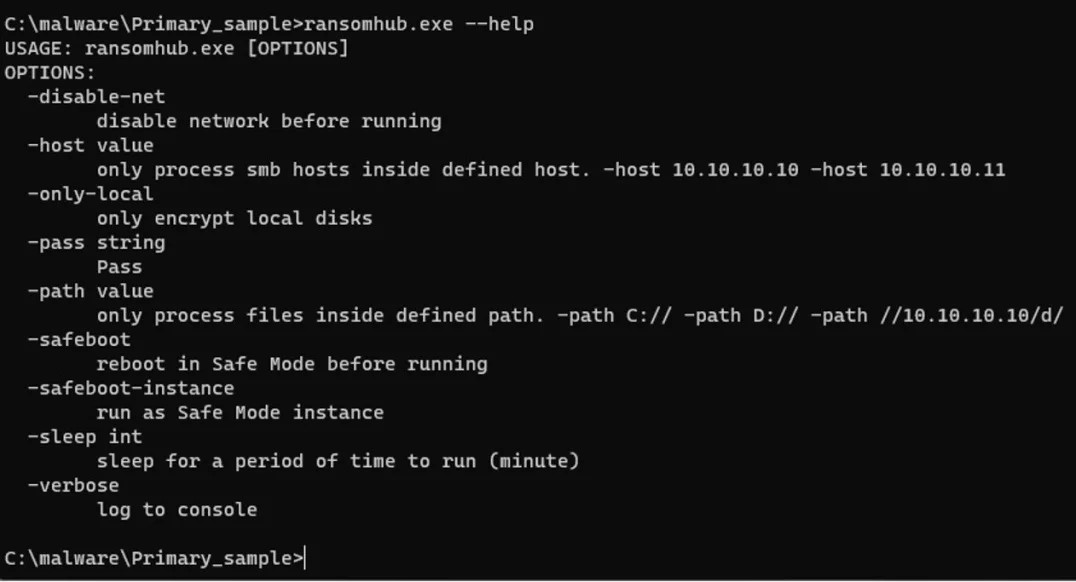RansomHub Ransomware
Original Issue Date:-
October 29, 2024
Virus Type:- Ransomware
Severity:-
High
It has been reported that RansomHub ransomware is aggressively targeting enterprises with double extortion attacks causing data exfiltration and encryption. RansomHub, operating as a Ransomware-as-a-Service (RaaS) is believed to be a rebranded version of Knight/Cyclops ransomware. The group focuses on the systems based on Windows, Linux, ESXi, NAS, and SFTP servers for attacks.
Infection Mechanism
RansomHub group typically compromises internet facing systems and user endpoints by using methods such as exploitation of known vulnerabilities, phishing emails, and password spraying.
Once inside the network, RansomHub affiliates use various tools to execute attacks, including EDRKillShifter, TDSSKiller, BITSAdmin, Cobalt Strike, Mimikatz, PSExec, PowerShell, RClone, Sliver, SMBExec, WinSCP, CrackMapExec, Kerberoast, and AngryIPScanner.
RansomHub ransomware typically leverages Elliptic Curve Encryption algorithm called Curve 25519 to encrypt accessible files on the systems and networked shares.


Indicator of Compromise:
Hashes:
- 02e9f0fbb7f3acea4fcf155dc7813e15c1c8d1c77c3ae31252720a9fa7454292
- 34e479181419efd0c00266bef0210f267beaa92116e18f33854ca420f65e2087
- 7539bd88d9bb42d280673b573fc0f5783f32db559c564b95ae33d720d9034f5a
- 8f59b4f0f53031c555ef7b2738d3a94ed73568504e6c07aa1f3fa3f1fd786de7
- ea9f0bd64a3ef44fe80ce1a25c387b562a6b87c4d202f24953c3d9204386cf00
- 104b22a45e4166a5473c9db924394e1fe681ef374970ed112edd089c4c8b83f2
- 2f3d82f7f8bd9ff2f145f9927be1ab16f8d7d61400083930e36b6b9ac5bbe2ad
- 36e5be9ed3ec960b40b5a9b07ba8e15d4d24ca6cd51607df21ac08cda55a5a8e
- 595cd80f8c84bc443eff619add01b86b8839097621cdd148f30e7e2214f2c8cb
- 7114288232e469ff368418005049cf9653fe5c1cdcfcd63d668c558b0a3470f2
- e654ef69635ab6a2c569b3f8059b06aee4bce937afb275ad4ec77c0e4a712f23
- fb9f9734d7966d6bc15cce5150abb63aadd4223924800f0b90dc07a311fb0a7e
- f1a6e08a5fd013f96facc4bb0d8dfb6940683f5bdfc161bd3a1de8189dea26d3
- a96a0ba7998a6956c8073b6eff9306398cc03fb9866e4cabf0810a69bb2a43b2
- 342b7b89082431c1ba088315c5ee81e89a94e36663f2ab8cfc27e17f7853ca2b
- 56856e1e275cebcd477e3a2995cd76398cfbb6c210181a14939c6307a82e6763
- 60b477dab8494d3a049cf3b17118a4124b68f9f7d3dcc3c92026ac86b00aae1e
- 30abbbeedeeb268435899a7697f7a72f37a38e60ae2430e09bc029c7a8aa7001
- 869758de8334c2b201a07cfbfc0a903105a113080dde0355857de46b3eaae08e
- bfbbba7d18be1aa2e85390fa69a761302756ee9348b7343af6f42f3b5d0a939c
- 490a7515445c2ebf8dfbe3791383ac050cd7fca5dcf0c4539f276ad21aa1afe7
- 7539bd88d9bb42d280673b573fc0f5783f32db559c564b95ae33d720d9034f5a
- 50d4a24a25be1e16b7805c6aff4436bae13623c5e26658871863875b2960771d
- f6c47853c53254342416263ea39715e44374be7627697f41788ab789a307f77e
- a0b3beae5a411b930ea3782fb708681ab2ad8d4806794ab594cbfe306a123e52
- 74fc8bd52429e23c863d9b407314e56eb88936f4028aab7564dea3cbf64c9aa7
- f6663774f9e46cb408c6865f725b27dcb314efbf5c9f3191484caeed32ead66f
- a7278ec4b2e2e1f6aacfe121dfb184603046f4f046e36a0c08d6044ed6a233c8
- b0d6a5e9949bf94cc9bf229a1edbb17136ea858b0ad7410676e6913966425302
- cfb787837a5563f91cfdaad054afd0b01524acb5208ebaf804c50e5b7e565741
- 2d823c8b6076e932d696e8cb8a2c5c5df6d392526cba8e39b64c43635f683009
- 467e49f1f795c1b08245ae621c59cdf06df630fc1631dc0059da9a032858a486
IP Addresses:
- 8.211.2[.]97
- 45.95.67[.]41
- 45.134.140[.]69
- 45.135.232[.]2
- 89.23.96[.]203
- 188.34.188[.]7
- 193.106.175[.]107
- 193.124.125[.]78
- 193.233.254[.]21
For additional IOCs pertaining to RansomHub ransomware, kindly refer URLs:
- https://www.cisa.gov/news-events/cybersecurity-advisories/aa24-242a
- https://documents.trendmicro.com/assets/txt/IoCsNzHTk7H.txt
Best Practices and Recommendations:
- Maintain offline backups of data, and regularly maintain backup and restoration. This practice will ensure the organization will not be severely interrupted, and have irretrievable data.
- Ensure all backup data is encrypted, immutable (i.e., cannot be altered or deleted) and covers the entire organization’s data infrastructure.
- Implement all accounts with password logins (e.g., service account, admin accounts, and domain admin accounts) to have strong, unique passwords.
- Implement multi-factor authentication for all services to the extent possible, particularly for webmail, virtual private networks, and accounts that access critical systems.
- Consider restricting/disabling command-line and scripting activities and permissions.
- Disable unused ports & services. Priortize hardening of internet-facing systems.
- Remove unnecessary access to administrative shares.
- Use a host-based firewall to only allow connections to administrative shares via server message block (SMB) from a limited set of administrator machines.
- Enable protected files in the Windows Operating System to prevent unauthorized changes to critical files.
- Disable Remote Desktop Connections, employ least-privileged accounts. Limit users who can log in using Remote Desktop, set an account lockout policy. Ensure proper RDP logging and configuration.
- Check regularly for the integrity of the information stored in the databases.
- Ensure integrity of the codes /scripts being used in database, authentication and sensitive systems.
- Establish Domain-based Message Authentication, Reporting, and Conformance (DMARC), DomainKeys Identified Mail (DKIM) and Sender Policy Framework (SPF) for your domain, which is an email validation system designed to prevent spam by detecting email spoofing by which most of the ransomware samples successfully reaches the corporate email boxes.
- Keep the operating system, software and firmware up-to-date with the latest patches. Prioritize patching known exploited vulnerabilities in internet-facing systems.
- Application white listing/Strict implementation of Software Restriction Policies (SRP) to block binaries running from %APPDATA% and %TEMP% paths. Ransomware sample drops and executes generally from these locations.
- Maintain updated Antivirus software on all systems.
- Don't open attachments in unsolicited emails, even if they come from people in your contact list, and never click on a URL contained in an unsolicited e-mail, even if the link seems benign. In cases of genuine URLs, close out the email and go to the organization's website directly through the browser.
- Follow safe practices when browsing the web. Ensure the web browsers are secured enough with appropriate content controls.
- Network segmentation and segregation into security zones - help protect sensitive information and critical services. Separate administrative network from business processes with physical controls and Virtual Local Area Networks.
- Disable ActiveX content in Microsoft Office applications such as Word, Excel, etc.
- Restrict access using firewalls and allow only to selected remote endpoints, VPN may also be used with a dedicated pool for RDP access.
- Use strong authentication protocols, such as Network Level Authentication (NLA) in Windows.
- Additional Security measures that may be considered are:
- Use RDP Gateways for better management.
- Change the listening port for Remote Desktop.
- Tunnel Remote Desktop connections through IPSec or SSH.
- Two-factor authentication may also be considered for highly critical systems.
- If not required consider disabling PowerShell / windows script hosting.
- Restrict users' abilities (permissions) to install and run unwanted software applications.
- Enable personal firewalls on workstations.
- Implement strict External Device (USB drive) usage policy.
- Employ data-at-rest and data-in-transit encryption.
- Consider installing Enhanced Mitigation Experience Toolkit, or similar host-level anti-exploitation tools.
- Block the attachments of file types, exe|pif|tmp|url|vb|vbe|scr|reg|cer|pst|cmd|com|bat|dll|dat|hlp|hta|js|wsf
- Carry out vulnerability Assessment and Penetration Testing (VAPT) and information security audit of critical networks/systems, especially database servers from CERT-IN empanelled auditors. Repeat audits at regular intervals.
- Individuals or organizations are not encouraged to pay the ransom, as this does not guarantee files will be released. Report such instances of fraud to CERT-In and Law Enforcement agencies.
References:
- https://www.cisa.gov/news-events/cybersecurity-advisories/aa24-242a
- https://www.trendmicro.com/en_in/research/24/i/how-ransomhub-ransomware-uses-edrkillshifter-to-disable-edr-and-.html
- https://www.security.com/threat-intelligence/ransomhub-knight-ransomware
- https://blog.checkpoint.com/research/august-2024s-most-wanted-malware-ransomhub-reigns-supreme-while-meow-ransomware-surges/
- https://thehackernews.com/2024/09/ransomhub-ransomware-group-targets-210.html
- https://www.group-ib.com/blog/ransomhub-raas/
- https://www.bleepingcomputer.com/news/security/fbi-ransomhub-ransomware-breached-210-victims-since-february/
- https://www.cert-in.org.in/PDF/RANSOMWARE_Report_2022.pdf
- https://www.csk.gov.in/alerts/ransomware.html


